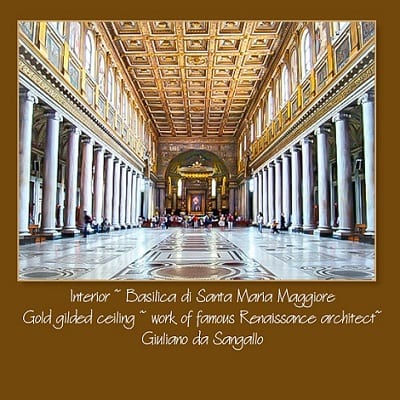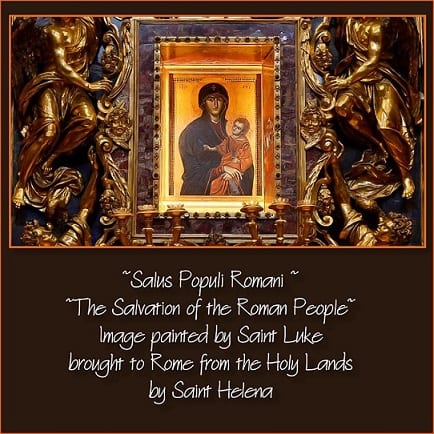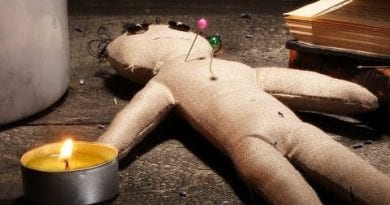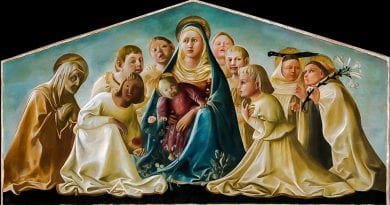Our Lady of the Snows
A Miraculous Snowfall Marks the Spot of One of the Most Important Basilicas in the World
Our Lady of the Snows
In the magnificent city of Rome, the most important church dedicated to Our Lady is the Basilica of Saint Mary Major. The basilica was built around the year 352, during the reign of Pope Liberius.
The Legend
The legend: John was a member of an upper-class family. He and his wife were preparing to retire. Having no children to inherit their wealth, they chose to consecrate their riches to the Church but they did not know how it would best be used. They prayed about this for many months but did not receive what they considered a clear answer. Needing advice, they took their quandary to their priest who suggested that they meet with Pope Liberius who was also the Bishop of Rome. John’s wife, having a devotion to Mary, felt that before they meet with the pope, they should first go to Our Lady in prayer.
The Dream
On the night of the third of August, Our Lady appeared in a dream to John, his wife, and Pope Liberius. She asked that they build a church in her honor for the Holy Sacrifice of the Mass and service of the Sacraments. She added that it was to be a large church so that its size could serve all from the area and beyond, and it was to be built upon the Esquiline Hill. She then told them that a sign, which would designate the exact location, would soon follow and said that this sign would mark the exact location in snow.
The following morning, John and his wife met with Pope Liberius who recommended that they begin their meeting with a prayer to Our Blessed Mother, asking for her guidance. Much to their surprise, they realized that Mary had visited all three in the same dream during the previous night. Excitedly, they agreed that it had to have been a miracle.
Pope Liberius asked that John and his wife fast and pray for the remainder of the day and he blessed the couple as they joyfully pledged their wealth to the Church, promising to do whatever Our Lady asked.
Beneath Thy Protection
After the couple had finished praying their usual evening prayers, they offered a special prayer to Our Lady for her continued love and protection.
They prayed that, if it was her Son’s will for them to offer their wealth for the building of the church she spoke of in their dream, that she would show them the sacred location. They then prayed an ancient prayer called Sub Tuum (meaning Beneath Thy Protection). Unbeknown to them, Pope Liberius was praying the same prayer at the same time.
The Miracle of the Snow
That midnight, when the date went from four August to five August, snow began to fall in Rome. It was, however, not the kind of snowfall that had ever been experienced in Rome. It was a hot August night when the snow began falling over the entire city, astonishing all who witnessed it. Many feared that it was an expression of God’s unhappiness with their behavior and ran from their homes, begging for His mercy. As unexpectedly as it began, the snow stopped. John, who had been awakened by the turmoil, rushed to his veranda in time to observe the snowfall beginning and by the time it stopped, his wife was awake and beside him. Initially saddened by the snow’s ending, John’s wife looked toward the Esquiline Hill and shouted, “Look! Look to the Esquiline Hill! It is snowing there!” Looking up toward the hill, John saw what appeared to be a brilliant glow over the entire hill. This glow became brighter and, eventually, was so brilliant that large snowflakes could be seen as silhouettes against its reflection. John and his wife observed with amazement until they finally fell asleep.
A Snowfall Answers John’s Prayer
At dawn, when they awoke, they ran to the Esquiline Hill. Pope Liberius, along with thousands of people from the city, arrived there at the same time. All wanted to witness the “Miracle of the Snows.” Realizing that the snow marked the exact location of the church, the people staked off the area before it melted.
Pope Liberius gathered all together and after leading them in praying the ancient prayer, “Beneath Thy Protection”, he declared the Esquiline Hill to be the site of the new church. John’s wife asked that it be dedicated to the Blessed Mother who had appeared to them. The church was named “Our Lady of The Snows” and is also referred to as the “Basilica Liberiana”, after the Pope who consecrated it, but today it is best known as the Basilica Saint Mary Major.
The Church is Complete
The couple donated all their wealth toward the building of the basilica. It was completed eleven years later and its first Mass was celebrated.
Pope Liberius proclaimed August fifth to be the Feast of Our lady of the Snows. Both John and his wife were buried in the nearby graveyard where their bodies lay under the shelter of Our Lady of the Snows.
The Basilica di Santa Maria Maggiore
John and his wife donated their fortune to build this church, never realizing all that it would become. Today it is known as the Basilica di Santa Maria Maggiore or church of Santa Maria Maggiore and in addition to being one of the most important Marian shrines in the world, it is a major Papal basilica. Because the church is home to the crib where the Baby Jesus was placed when He was born, it is sometimes referred to as the Church of Saint Mary of the Crib.
Artwork and Architecture
Saint Mary Major contains some of the finest artwork and architectural wonders in the world. Its ceiling is gilded with the first gold brought to Spain from the New World. Christopher Columbus presented it to Pope Alexander VI as a gift from Ferdinand and Isabella of Spain. This magnificent ceiling is a Renaissance masterpiece created by Giuliano da Sangallo, a famous Italian sculptor, and architect.
Treasures, Relics, and History
The two most significant Christian possessions which are held in the basilica are the relic of the manger where the Baby Jesus was laid. It is honored under the High Altar which faces a marble statue of Pope Pius IX, who proclaimed the dogma of the Immaculate Conception in 1854.
The second is a painting of Our Lady known as the Salus Populi Romani (The Salvation of the Roman People).
This painting was brought from the Holy land to Rome by Saint Helena and is believed to have been painted by Saint Luke.
During the pontificate of Pope Saint Gregory the Great (590-604), the people of Rome were stricken by a plague. In a procession, Pope Saint Gregory carried the image to pray to Our Lady for an end to the plague. When it ended, he placed crowns of gold and gems on the heads of Mary and the child Jesus on the miraculous image.
The basilica also holds the body of Saint Jerome who died with his head in the crib, and relics of Saint Matthias, the Apostle, who took the place of Judas Iscariot. Pope Sixtus V and Pope Saint Pius V are entombed there.
Little Did They Know
In the year 350, when John and his wife consecrated their wealth to Our Lady, promising to build a church on the Esquiline Hill, little did they know that over sixteen hundred years later, this church would be one of the most important Marian shrines in the world and a major Papal basilica. Little did they know that it would become the home of the Infant Jesus’s crib and some of the most magnificent and significant relics, art and architecture. They did know that if they went to Mary, their prayers would be answered. They just didn’t realize the scale of their answer, but Mary Our Mother knew exactly what that church would become when she gave them a blueprint in the snow.
Marilyn Nash

http://www.Gardenias4Lina.com/Our_Lady_of_the_Snows_Rosaryhtml

~ Giuliano da Sangallo ~

~ The Salvation of the Roman People ~
~believed to have been painted by Saint Luke ~





